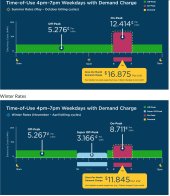k490
Solar Enthusiast
Trying to figure out if it's feasible to try and off load my highest power consumption appliances to a battery and inverter system for 3 hour a day during peak usage rate. I live in the desert it's hot been over 115F for a while now. My biggest part of my bill is a demand charge. This is where they monitor for the highest 15 minutes a day of KW usage and multiply that by a number. The result is my bill is $375 of that the demand part is $189 of it. Even in the winter we don't even use the heat pump the demand charge can be $80-$100 with a total bill of $189.
My 4-ton heat pump draws 20 amps while running I measured it when it was 115F outside 4800 watts I will install a soft start keep the startup current down. If I charge during the off-peak at 6 cents a KW into 30kwh of batteries that should get me through the 3 hours. The question is does any inverter exist that can connect in and add power to the system or is it like I think any off-grid inverter will need to be re-wired between the load and the grid.
I looked into sever rack batteries the ROI is too high but DIY building from cell packs might be feasible 15kw at 48V is $2000 shipped about 12 cents a watt. I know those Chinese sellers might be a problem let's just set that aside for now. I'm just looking at the numbers and how can I wire it what the ROI would be. It would be nice if something could just wire in parallel to the grid mains and add power when it senses power being pulled. I know that is what a grid-tie seems like there is no inverter that grid-ties like that with batteries.
My 4-ton heat pump draws 20 amps while running I measured it when it was 115F outside 4800 watts I will install a soft start keep the startup current down. If I charge during the off-peak at 6 cents a KW into 30kwh of batteries that should get me through the 3 hours. The question is does any inverter exist that can connect in and add power to the system or is it like I think any off-grid inverter will need to be re-wired between the load and the grid.
I looked into sever rack batteries the ROI is too high but DIY building from cell packs might be feasible 15kw at 48V is $2000 shipped about 12 cents a watt. I know those Chinese sellers might be a problem let's just set that aside for now. I'm just looking at the numbers and how can I wire it what the ROI would be. It would be nice if something could just wire in parallel to the grid mains and add power when it senses power being pulled. I know that is what a grid-tie seems like there is no inverter that grid-ties like that with batteries.





